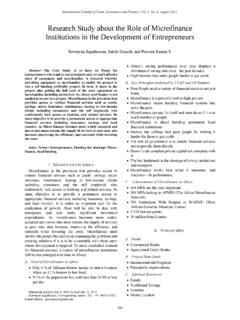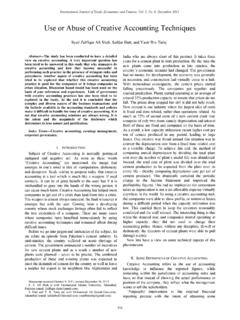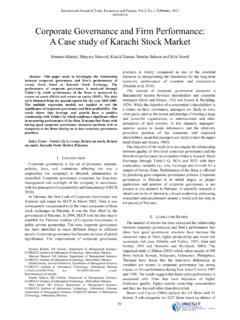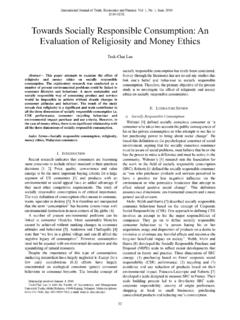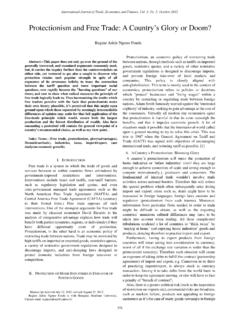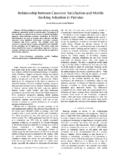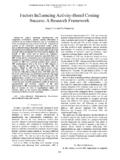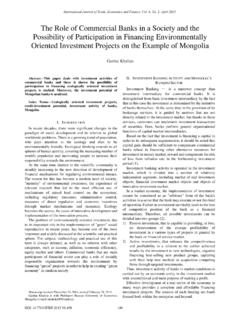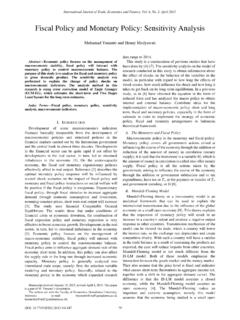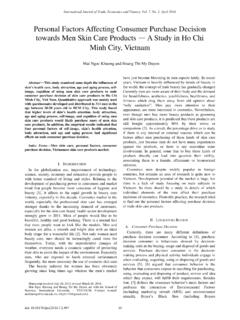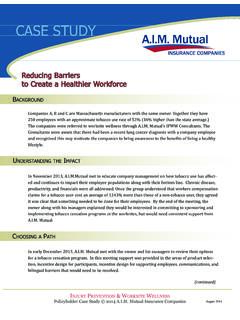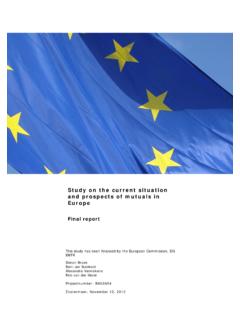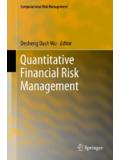Transcription of Risk Assessment Model for Assessing NBFCs’ (Asset ...
1 International Journal of Trade, Economics and Finance, Vol. 1, No. 1, June, 2010 2010-023X 121 Abstract Non-banking financial companies ( nbfcs ) form an integral part of the Indian financial system. The history of the NBFC Industry in India is a story of under-regulation followed by over-regulation. Policy makers have swung from one extreme position to another in their attempt to set controls and then restrain them so that they do not curb the growth of the industry. This report covers the industry. Most of this nbfcs are operating with high risk of lending and more often nbfcs lend credit to Small and Medium size enterprises, which are categorized as high risk class of Assets. To assess such high risk assets we need to have a comprehensive Model .
2 This paper aim is to build Risk Assessment Model for nbfcs based on both qualitative and quantitative aspects of the client. Index Terms NBFC, Asset Financing, Risk, Credit Rating I. INTRODUCTION A. Industry Non-banking financial companies ( nbfcs ) form an integral part of the Indian financial system. The history of the NBFC Industry in India is a story of under-regulation followed by over-regulation. Policy makers have swung from one extreme position to another in their attempt to set controls and then restrain them so that they do not curb the growth of the industry. This report covers the industry. Non-banking financial companies ( nbfcs ) have seen considerable business Model shift over last decade because of regulatory environment and market dynamics.
3 In the early 2000s, the NBFC sector in India was facing following problems: 1) High cost of funds 2) Slow industrial growth 3) Stiff competition with nbfcs as well as with banking sector 4) Small balance sheet size resulting in high cost of fund and low asset profile 5) Non performing assets Majority of nbfcs were not able to face the pressure created on and were wiped out. However, since FY2001-2002, there has been significant improvement in the business Model of existing nbfcs with improvement in overall business environment. nbfcs have been able to expand their resource profile by diversifying the funding avenues. Further a strict control on asset quality and overheads, coupled with use of innovative borrowing tools such as securitization has resulted in improved profitability of nbfcs .
4 School of Management Dr. Alagappa University B. Key Insights about NBFC Sector as of Today As per CRISIL's NBFC sector report, Net profitability margin of nbfcs has more than doubled from FY2000-01 to FY2001-02 as growing interest spread is key to profitability. 1) Higher Interest yield than banks Further on the whole, nbfcs have higher interest yields than banks. The difference in their interest yield can be attributed to the following reasons: - Some nbfcs have a wide reach and traditional niche strengths. Also they have forged good customer relationships in their respective operating geographies. This has led to higher interest yield incomes as they have been able to command a premium. Vehicle finance nbfcs have shown an increasing trend in the component of used vehicles financing in their portfolio.
5 Which offer a higher internal rate of return than new vehicles? 2) Marginal increase in fee based income aided profitability The core fee income of all nbfcs improved marginally in FY2002-03. 3) Strict control on overheads help maintain core profitability As per CRISIL study, the nbfcs have managed to control any significant increase in their overheads in spite of the expansion in their business and reach. 4) Enhanced investor base and funding avenues bolster resources profile The nbfcs business Model has strengthened considerably over the past few years in terms of access to varied funding sources. The growth of mutual fund industry and the emergence of securitization as a borrowing tool have helped to strengthen the NBFC sector.
6 In the near term, nbfcs will continue to maintain their core profitability at close to their FY2002-03 level. Interest costs have declined in FY2003-04 as well, which will enable them to maintain their interest spreads, since interest yields are not expected to decline significantly in the near term. This coupled with the control on overheads, will enable nbfcs to maintain their core profitability in the near term In today s scenario nbfcs (Non Banking Financial companies ) are facing a lot of competition from the banking sector nationalized as well as from the foreign banks. In liberalized economy, service differentiation has become insignificant and companies are trying to differentiate their offer by various augmentations in the service level.
7 The relatively lucrative spreads in the retail financing market will attracts both banking companies and nbfcs , thus intensifying competition and in turn bringing pressure Risk Assessment Model for Assessing nbfcs (Asset Financing) Customers Srinivas Gumparthi SSn International Journal of Trade, Economics and Finance, Vol. 1, No. 1, June, 2010 2010-023X 122on spreads. However, for the public sector banks to emerge as serious competition for the top-rated nbfcs , significant changes in the way they operate are a must. Otherwise, the public sector banks can only chip away at their market share in non-metro locations, not take it over entirely. Current commercial vehicle and construction equipment financing is quite crowded with lots of financing companies coming into this line.
8 The list includes ICICI, HDFC Bank, Kotak Mahindra Finance, Cholamandalam Investment & Finance, Sundaram Finance, LGF, Tata Finance, Citi Corp, Sivagami Finance & Investments, Ashok Leyland Finance Limited and Centurion Bank Limited being the active partners in this sector. Only smart financing option and service level are a positive influence. The commercial vehicles financing segment is a large proportion of the financing market. For nbfcs , commercial vehicles financing account for a much larger proportion of their disbursements. After a few moribund years, activity in the commercial vehicle market has picked up. This is reflected in the growth in disbursements of nbfcs too. Over the long term, however, the rate of growth in commercial vehicle financing is likely to be linked to the economy's growth dominated by cyclical activity.
9 Conscious of such cyclicality, top-rated nbfcs are intent on diversifying their revenue profile. Some such as Sundaram Finance and Cholamandalam have forayed into asset management and insurance. Sundaram Finance is also into housing finance. Commercial vehicle sales up by per cent during April-December 2003 as a robust manufacturing sector, construction of highways and abundant rainfall continued to keep automakers busy. A total of lakh buses and trucks were sold during the period against lakh units a year ago, says a data compiled by the Society of Indian Automobile Manufacturers. While medium and heavy (M&H) bus and truck sales jumped per cent to lakh units that of light commercial vehicles went up by 29 per cent to 68,707 units.
10 In the M&H segment, sale of trucks grew per cent to 92,055 units while that of buses went up by per cent to 17,366 units. Sale of light trucks also jumped by per cent to 55,057 units but light buses suffered a per cent drop to 13,650 units. A resurgent manufacturing sector, especially cement and steel, has also boosted truck sales this fiscal. Abundant rains last year also helped to improve sentiments on expectations of better agricultural production and led to more demand in the rural areas, analysts said. Demand for trucks, mainly M&H vehicles, has been on the upswing due to speedy progress on various highway projects. Generally, due to the amount of capital involved in the purchase of these assets, the growth in demand for them is directly proportionate to the demand for finance.
